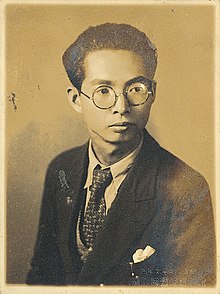The Torment of a Flower
You can help expand this article with text translated from the corresponding article in Chinese. (April 2016) Click [show] for important translation instructions.
|
| "雨夜花" | |
|---|---|
| Song | |
| Language | Taiwanese Hokkien |
| English title | Torment of a Flower |
| Published | 1934 |
| Composer(s) | Teng Yu-hsien (鄧雨賢) |
| Lyricist(s) | Chiu Thiam-ōng (周添旺) |

"The Torment of a Flower" (Chinese: 雨夜花; Pe̍h-ōe-jī: Ú-iā-hoe; lit. 'a flower at rainy night'), also known as "Rainy Night Flower", is a 1934 Taiwanese Hokkien song composed by Teng Yu-hsien and written by Chiu Thiam-ōng.[1][2][3]
About
[edit]Taiwanese writer Liau Han-sin (廖漢臣) wrote the lyrics of a children's song "Spring" (春天) and gave it to Teng Yu-hsien, asking him to compose for it. This was the earliest version of "The Torment of a Flower". Although Teng is a Hakka, he usually composed with Taiwanese Hokkien and not Hakka.[4] Some scholars have questioned this story about children's songs.[5][6]
In 1934, while Chiu Thiam-ōng was working at record company Taiwan Columbia (古倫美亞唱片), he once went to a nightclub and heard a sad story about a girl who worked there.[7][8] Chiu was touched, and he decided to rewrite the lyrics of "Spring", wrote the story into Teng's music, that is "The Torment of a Flower".[9] It is the first collaborative work between Teng and Chiu. Especially, there was usually three part lyrics in Taiwanese Hokkien songs then, but there are four parts in "The Torment of a Flower".[10][11]
雨夜花,雨夜花,受風雨吹落地。無人看見,每日怨慼,花謝落塗不再回。
— Chiu Thiam-ōng, The Torment of a Flower
The first part of the lyrics means: "Blossom in a stormy night, pelted to the ground by the rain and wind. All by my lonesome, no one sees my constant grief for the blossom falling into the dirt that has no hope of revival."
During the Second World War, the Japanese Imperial Warlord tampered with the lyrics of the song to declare that the Taiwanese under their rule love Japan. The Japanese version includes the line "How excited the honorable Japanese soldiers who wear red ribbons." (紅色彩帶,榮譽軍伕,多麼興奮,日本男兒。)[4]
The song was played twice on a piano in the 2017 horror game Detention.[12]
Notable performances
[edit]- Placido Domingo sang this song with Jody Chiang in Taipei Concert Hall.
- The 2010 S.H.E song I Love Rainy Night Flower is a partial cover of "The Torment of a Flower".
- Hayley Westenra performed the song at a 2010 concert in Kaohsiung.
- Rainy Night Flower/RNF, a 2011 television drama series produced by Sanlih Television, was inspired by the song.
References
[edit]- ^ "三月迎春四月望雨-紀念臺灣歌謠之父鄧雨賢先生特展". archives.lib.ntnu.edu.tw. Retrieved 20 October 2023.
- ^ "雨夜花 - 臺灣音聲一百年". audio.nmth.gov.tw (in Chinese (Taiwan)). Retrieved 20 October 2023.
- ^ 鄧泰超. "雨夜花". 開放博物館 (in Traditional Chinese). Retrieved 20 October 2023.
- ^ a b Chuang, Yung-ming (3 April 2014). "80年前的今天,雨夜花落知多少?" [How much do we still know about The Torment of a Flower 80 years later?]. The News Lens (in Traditional Chinese). Archived from the original on 27 May 2018. Retrieved 27 May 2018.
- ^ "上善人文基金會". www.sshcf.org.tw. Retrieved 20 October 2023.
- ^ ":: 奇美博物館提琴收藏數位典藏計畫 ::". cm2.chimeimuseum.org. Retrieved 20 October 2023.
- ^ "【民報】【專文】雨夜花與時代的對話". www.peoplemedia.tw (in Chinese (Taiwan)). 22 July 2017. Retrieved 20 October 2023.
- ^ "傳唱83年 鄧兆旻邀經典老歌《雨夜花》談人生". 非池中藝術網. Retrieved 20 October 2023.
- ^ 中華民國文化部. "雨夜花-文化部國家文化記憶庫". memory.culture.tw (in Chinese (Taiwan)). Retrieved 20 October 2023.
- ^ "純純 - 台視官網". 台視. Retrieved 20 October 2023.
- ^ 黃惠君 (2006). 雨夜花飄望春風:台灣歌謠奇才鄧雨賢和他的音樂時代. 臺北市政府文化局. ISBN 9860075182.
- ^ "DETENTION Full Game Walkthrough - No Commentary (#Detention Full Game) 2017". YouTube. 13 January 2017.
